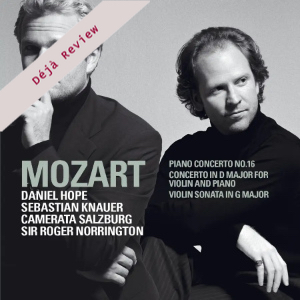
Déjà Review: this review was first published in August 2005 and the recording is still available.
Wolfgang Amadeus Mozart (1756-1791)
Piano Concerto No. 16 in D major, K. 451
Sonata in G major for violin and piano, K. 379
Concerto in D major for violin and piano, K. App. 56/K. 315f
Daniel Hope (violin)
Sebastian Knauer (piano)
Camerata Salzburg/Sir Roger Norrington
rec. 2004, Main Hall of the Mozarteum, Salzburg, Austria
Warner Classics 2564 619442 [68]
Although it is a fairly common practice, attempting to complete a composer’s unfinished works never fails to elicit extreme reactions. Perhaps Toscanini’s decision to stop the world premiere of Turandot in the middle of Act III (where Puccini ceased working) stands as the most famous and public acknowledgement of a work completed by one other than its composer. This all-Mozart disc (or should I say, “This almost all-Mozart disc) features a work that was never finished in the composer’s lifetime. In fact, of the work’s three movements, not even the first reached fruition. The final selection on this disc, the Concerto in D major for violin and piano, has been reconstructed and completed by Philip Wilby, a composer and professional violinist. The reconstruction is of serious length, as Mozart had only composed the first 120 bars of the first movement. In his liner notes, Wilby makes a convincing case for assuming that this double concerto was to be, essentially, a re-working of Mozart’s Sonata for violin and piano in D major, K. 306. Based on this assumption, Wilby completed the first movement of the concerto with music from the sonata and rounded the piece off by orchestrating the final two movements of the sonata.
Whatever one’s personal feelings may be regarding reconstructions such as this, Wilby’s product is top-notch. He does an admirable job imitating Mozart: moments in which the piece sounds un-Mozartean are few and far between. The orchestration is colorful and playful, and all instruments are used idiomatically. The Camerata Salzburg gives a crisp and inspiring performance. The violins play with impeccable union and a beautiful ensemble tone. The winds, so often more of a liability than an asset, play with charisma and finesse. Occasionally, in this and other selections on the disc, the Camerata’s phrasing is a bit heavy. This is, however, a small criticism. The soloists’ performances demonstrate amazing rapport and teamwork. It seems a cliché to describe their playing as conversational, but in many ways, that is exactly what it is. They seem to be in constant communication, each taking the lead occasionally and only when appropriate. It is reminiscent of professional ball-room dancing: lifts and turns of amazing complexity seem effortless, and their success in making it seem so simple is a result of pure cooperation. The first and second movements of this “new” Mozart concerto are not to be missed. The opening movement displays an infectious mischievousness that is marvelously extended for its duration. The second movement is stunning in its elegance and introspection as well as Knauer’s success in soliciting a wide range of ravishing color from his instrument.
The remaining two works on the disc, the Piano concerto in D major and the Sonata in G major, are fairly standard works and are given here in reasonably good performances. Knauer’s playing in the concerto is exciting and colorful. The piece, however, is almost more of a showcase for the ensemble than it is for the soloist. Symphonic in nature, it features a wide instrumental palate, featuring the flute in many moments. With this in mind, balance could have been greatly improved had the upper strings played a bit softer and allowed instruments (such as the flute) to ring a bit more audibly. The Sonata in G major is full of quirks. A two-movement work, one of which is a theme and variations, it was, as Wilby explains, an attempt by Mozart to gain notoriety in the amateur market. It displays aplomb simplicity, but also a profound sincerity and elegance — especially the set of variations. In many instances, the violin takes a backseat to the piano, and in these spots, Knauer truly excels. His passagework is precise and articulate without being percussive. Hope plays well in most cases; however, many of the less demanding sections seem dull and somewhat uninspired. Oftentimes, these technically “easy” moments require the most communicative help from the performer to avoid a lackluster execution. In spite of these few issues, the sonata is a pleasant listen.
This disc is definitely one to own. The newly completed double concerto provides sufficient motivation in and of itself. It’s not often that “new” Mozart pieces become available.
Jonathan Rohr
If you purchase this recording using a link below, it generates revenue for MWI and helps us maintain free access to the site



















